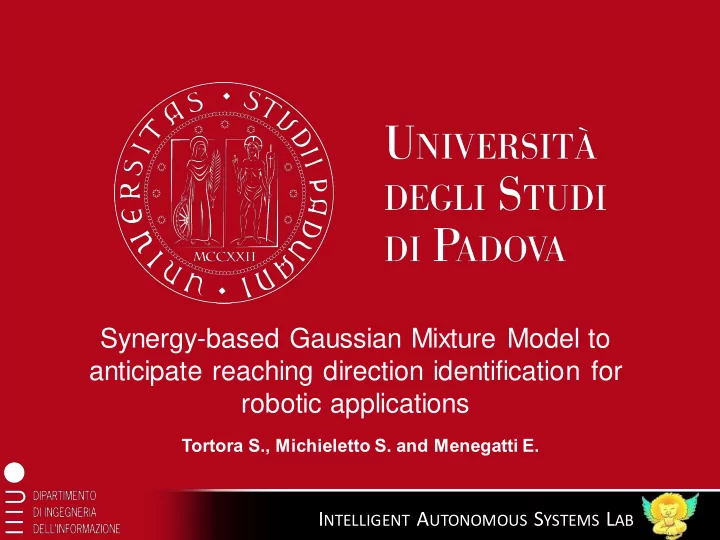

Synergy-based Gaussian Mixture Model to anticipate reaching direction identification for robotic applications Tortora S., Michieletto S. and Menegatti E. I NTELLIGENT A UTONOMOUS S YSTEMS L AB
EMG control of robotic devices IAS-L AB Regression feedback
EMG control in hemiparetic subjects IAS-L AB Muscle weakness is the major impairment in stroke and spinal- cord injury (SCI) subjects x Continuous and direct control is unfeasible Assistive devices x Dangerous behavior due to spastic movements and tremors x For severe disability only passive Rehabilitation devices stretching x Movement guidance requires known end-points
Anticipate detection and Shared autonomy IAS-L AB Discrete control through classification model Continuous control through regression model Shared autonomy through on-board intelligence Classification feedback
Experimental protocol IAS-L AB Protocol: • 3 sessions • Each session: 20 trials per target • 1 healthy subject
Proposed model scheme IAS-L AB training Notch (50 Hz), BPF (5-200 Hz), rectify, smoothing, normalization Non-Negative nSRE W Gaussian Mixture Model EMG Preprocessing Matrix Factorization (GMM) (NMF) nSRE H Non-Negative Least Squares w(t) π, μ , Σ GMM Classification 𝑞 𝜎 𝜕 Evidence Normalization class ζ accumulation Layer
Preprocessing: nSRE IAS-L AB
Proposed model scheme IAS-L AB training Non-Negative nSRE W Gaussian Mixture Model EMG Preprocessing Matrix Factorization (GMM) (NMF) nSRE H Non-Negative Least Squares w(t) π, μ , Σ GMM Classification 𝑞 𝜎 𝜕 Evidence Normalization class ζ accumulation Layer
Synergies extraction: NMF IAS-L AB 𝑂 𝑡𝑧𝑜 𝑦 𝑛 𝑢 = ℎ 𝑛,𝑜 𝑥 𝑜 (𝑢) 𝑜=1 X H W 𝑊𝐵𝐺 = 1 − σ 𝑗 ( ത 𝑌 − 𝑌) 2 σ 𝑗 𝑌 2 Non-Negative Matrix Factorization: find H and W by minimizing the divergence D(X||HW), subjects to the training constraints W, H ≥ 0 Minimum N syn for which: 𝑌 𝑛,𝑜 Total VAF ≥ 90% 𝐸(𝑌| 𝐼𝑋 = 𝑌 𝑛,𝑜 log − 𝑌 𝑛,𝑜 − (𝐼𝑋) 𝑛,𝑜 1. (𝐼𝑋) 𝑛,𝑜 𝑛,𝑜 For each muscle VAF ≥ 90% or 2. Δ V AF < 5% Non-Negative Least Squares: find w solving For each target V AF ≥ 90% or 3. test 2 , Δ V AF < 5% min 𝐼𝑥 − 𝑦 𝑥ℎ𝑓𝑠𝑓 𝑥 ≥ 0 2 𝑥
Synergies extraction: NMF IAS-L AB
Proposed model scheme IAS-L AB training Non-Negative nSRE W Gaussian Mixture Model EMG Preprocessing Matrix Factorization (GMM) (NMF) nSRE H Non-Negative Least Squares w(t) π, μ , Σ GMM Classification 𝑞 𝜎 𝜕 Evidence Normalization class ζ accumulation Layer
Gaussian Mixture Classification IAS-L AB Training: 𝐿 𝑞𝑒𝑔 𝜊 = 𝜌 𝑙 𝒪 𝜊; 𝜈 𝑙 ,Σ 𝑙 𝑙=1 w n (t) 𝜊 = {𝑥, 𝜂} Weighted sum of K Gaussian components N syn synergies Target direction activation vector of the movement related to w t 𝐿 𝜌 𝑙 𝒪(𝑥|𝜈 𝑥,𝑙 , Σ 𝑥,𝑙 ) 1 2 T Class 1 𝑞𝑒𝑔 𝜂 𝑥 = 𝐿 𝒪(𝑥|𝜈 𝑥,𝑗 ,Σ 𝑥,𝑗 ) 𝐹[𝜎 𝑙 |𝑥] 1. σ 𝑗 Class 2 𝑙=1 … Class L 𝑞𝑠𝑝𝑐𝑏𝑐𝑗𝑚𝑗𝑢𝑧 𝑞 𝜂 𝑥 2. Column normalization
Proposed model scheme IAS-L AB training Non-Negative nSRE W Gaussian Mixture Model EMG Preprocessing Matrix Factorization (GMM) (NMF) nSRE 𝑢−1 H Non-Negative 1. 𝑞 𝜎 𝑥(𝑢) = 𝑞 𝜎 𝑥(𝑢) + 𝑞 𝜎 𝑥(𝜐) Least Squares 𝜐=0 𝑀 𝑔𝑔𝑒𝑒 w(t) 2. 𝑞 𝜎 𝑥(𝑢) = 𝑞 𝜎 𝑥(𝑢) / 𝑞 𝑚 𝑥(𝑢) 𝑚 π, μ , Σ GMM 3. 𝑇𝑓𝑚𝑓𝑑𝑢 𝑑𝑚𝑏𝑡𝑡 𝜂: max 𝑞 𝜎 𝑥(𝑢) Classification 𝜂 𝑞 𝜎 𝑥(𝑢) Evidence Normalization class ζ accumulation Layer
Classification results IAS-L AB 𝐻𝑏𝑣𝑡𝑡𝑗𝑏𝑜 𝑑𝑝𝑛𝑞𝑝𝑜𝑓𝑜𝑢𝑡, 𝐿 = 3
Classification results IAS-L AB 𝐿 = 3 𝐿 = 10
Robot control IAS-L AB
Robot control IAS-L AB Target: UP Target: RIGHT Target: DOWN Target: LEFT
Conclusions IAS-L AB The proposed method achieved: Task-indipendent synergies representing movement primitives 98% of accuracy (K = 3) at 20% of reaching distance (about 100 ms after movement onset) Respect of real-time constraints Limitations and future works: • Test on a bigger healthy population (check the repatability of the synergy modules and develop a healthy-like model ) • Test on stroke or SCI patients (Rehabilitation therapy exploiting the healthy-like model) • Include time-dependent parameters in the model (To identify sudden changing of direction)
Thanks for the attention! I NTELLIGENT A UTONOMOUS S YSTEMS L AB
Recommend
More recommend